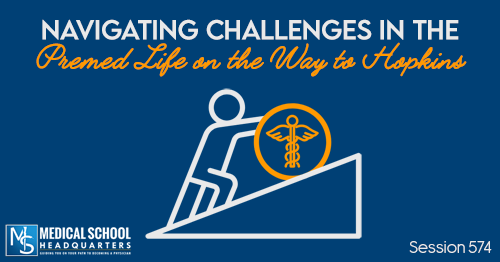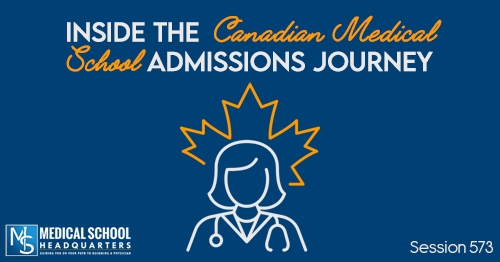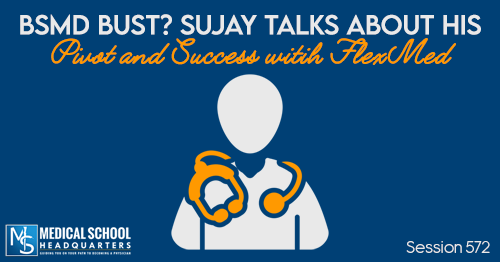Apple Podcasts | Google Podcasts

Session 225
Our guest today is Rachel, the Junior National Director of Pre-SOMA (Pre- Student Osteopathic Medical Association). She shares with us her story as well as some answers to common questions about osteopathic medicine that premeds have.
Rachel talks about applying to medical school, taking gap years, why DO should not just be a “plan B,” and more information about how Pre-SOMA can help you become an osteopathic physician.
Listen to this podcast episode with the player above, or keep reading for the highlights and takeaway points.
[01:24] Rachel’s Interest in Science and Medicine
When she was around 5th-6th grade, Rachel took an interest in the sciences. Without any background in medicine growing up, she didn’t have much knowledge of what day-to-day life was like for a physician—but the idea popped into her mind.
Without any background in medicine growing up, she didn't have much knowledge of what day-to-day life was like for a physician.Click To TweetAs she got into middle school, Rachel focused more on science-type electives and enjoyed it. Because of her limited exposure to medicine at that time, she equated science only to medicine or medical school, and not to being a scientist, a researcher, a nurse, or a physical therapist.
When she got to high school, their school system had specialized public high schools. She applied to a medical scientist high school program and got in. Throughout high school, Rachel was all about being a doctor and still had limited exposure to other fields that use science, such as nursing, physical therapy, dentistry, or medical research.
Rachel had a unique opportunity during her sophomore year of high school to go on rotations in the local hospital and follow around the nursing staff. They also got to shadow a doctor for half of their senior year of high school. Rachel got to shadow a plastic surgeon. At that point, Rachel was convinced it was what she wanted to do.
[07:00] High School: Shadowing and Mentorship
The part of her shadowing experience in high school that reaffirmed her decision to become a doctor was seeing a person in a white coat that can influence a person’s life and the decisions they make for their health and their future. Plus, she got so inspired by the fact that she shadowed a plastic surgeon who was a female, had four kids, and was still be able to raise a family while having a profound impact on people’s lives.
She got so inspired by the fact that she shadowed a plastic surgeon who was a female, had four kids, and was still be able to raise a family while having a profound impact on people's lives.Click To TweetRachel also got to work for their family friend, a Hematologist-Oncologist. She was in charge of filing and organizing medical charts and answering phone calls. She was then able to differentiate the work of a plastic surgeon from being an oncologist. Being able to see cancer patients being treated reaffirmed her desire to have an influence in other people’s lives. She was in awe of these physicians and motivated to be like them.
[09:45] Being Premed at NYU and Trying to Access Premed Advising
Rachel got into NYU. She quickly figured out, being eighteen years old and living in the heart of downtown Manhattan, that she had no idea of what she was doing. Rachel didn’t know how to take control of her studies or how to handle the rigorous premed curriculum. She didn’t know how to study and stand out in a group of over 800 premed students. She just didn’t know how to build an impressive enough application to get into medical school. In short, Rachel wasn’t happy with how college was going for her.
She didn't know how to study and stand out in a group of over 800 premed students at NYU.Click To TweetAfter a year of studying biology, Rachel talked to a friend of hers who was also premed but was studying Nutrition and Food Studies and really enjoying it. So Rachel decided to switch over to a Nutrition and Food Studies major, and she did keep the premed coursework, as well. But she still didn’t really know where to start in terms of extracurricular activities and volunteering that she would both enjoy and would look good on her med school application.
Premed Advising Problems at NYU
Because NYU was such a large university, Rachel didn’t actually know how to access the premed and pre-health offices and their services for a good two years of college. And while there, she didn’t really feel she got the right kind of support she needed.
Rachel needed hand-holding in the beginning, but the advisors were so grade-centered and grade-focused. If you’re not getting A’s in your premed classes, then they won’t encourage you to apply to med school, and if you do, they can’t help you because your grades are not great. This is why I say don’t believe everything you hear from premed advisors.
Here’s a nasty detail that pre-health advising offices won’t tell you: If you don’t meet their grade qualifications, they don’t want to help you, because then they can leave you off their stats and brag about their 98% acceptance rate to medical school. Rachel wished that at least there was somebody there who could tell her another way to get into medical school.
[Related episode: Is the Role of the Premed Advisor to Tell You No?]
[15:50] Course Correction: Strengthening the Weaknesses in Your Medical School Application
It took Rachel till the end of her junior year to realize that she was able to seek tutoring and mentorship outside of NYU. She then decided it was wise to focus on what was weak on her application and take 1-2 years to strengthen those weaknesses. So she took two years off before getting into medical school.
Rachel’s mentor helped her determine the weak points in her application. They laid out everything on the table, assessing her grades, GPA, extracurriculars, volunteering, and clinical job experience.
At that point, Rachel had not yet taken the MCAT. Her nutrition grades were excellent, and her Nutrition GPA was high. But her premed science GPA was not good at 2.7. This was what was needed to be fixed and what she had to focus on over the next 1-2 years before submitting her application. Since it was her undergrad GPA that needed fixing, there was no need to take grad classes.
Rachel’s Informal Postbac to Fix Her Medical School Application
Instead of enrolling in a formal postbac program, Rachel decided to enroll at a local university (in New Jersey) and just register for upper-level science courses. She then started building her courseload and registering for as many biology classes as possible. Initially, the school told her she didn’t have the prerequisites to be taking upper-level science courses. But through the advice of her mentor, she went to the biology office and stated her case to them, promising she will ace those courses.
She took 60 credits of coursework that year and finished with a 3.999 GPA. At that time, her professor let her into his microbiology lab. Rachel was grateful for this research opportunity.
I decided it would be wise to focus on what was weak on my med school application and take one to two years to strengthen those weaknesses.Click To Tweet[21:45] AACOMAS Application: Grade Replacement and the New Policy Change
On the AACOMAS application (for DO schools) in the past, for any classes repeated, you didn’t put any credit hours in for the old class—only the retake counted toward your GPA.
But there’s a new policy change where they’re now doing it how the MD application works, where all the grades are counted together to get your average. So your postbac classes are no longer going to replace your old grades for the AACOMAS application. They’re just going to average out.
If we took a snapshot of what your med school application looks like today, what could we pinpoint that could be improved?Click To Tweet[Related episode: What You Need to Know About AACOM Killing Grade Replacement.]
Regretting Being Premed at NYU
Did Rachel regret going to NYU for her premed years? Initially, yes. But she realized that being at NYU and in New York City was a unique experience for her. What she wished she knew was that it’s okay to take some time off before going to medical school.
She wished she knew it was okay to take some time off before going to medical school.Click To TweetIf she was doing it all over again, she would have just enjoyed studying Nutrition and Food Studies or some other major at a place like NYU. Then she would have done a postbac premed program after she graduated when she was at a higher level of maturity and focused on building a great application.
[26:15] About Pre-SOMA and How It Helps Osteopathic Premed Students
Pre-SOMA (Pre-Student Osteopathic Medical Association) is the undergrad division of the larger Student Osteopathic Medical Association (SOMA), which is the student portal to the osteopathic medicine community. They’re the direct student voice of the American Osteopathic Association. Students can speak up on issues important to medical education and their future careers as physicians.
Pre-SOMA (Pre-Student Osteopathic Medical Association) is the undergrad division of the larger Student Osteopathic Medical Association (SOMA).Click To TweetNaturally, SOMA seeks to mentor and nurture those interested in applying to osteopathic medical schools. SOMA and Pre-SOMA are solely led by osteopathic medical students.
Pre-SOMA members spend time rotating through hospitals, sitting through classes, and volunteering their time to the organization’s growth. Pre-SOMA currently has 1,200 premed members, many of which are part of 30 active chapters at universities nationwide.
Nationally, Pre-SOMA works hard to promote the osteopathic medical profession, increase the number of applicants to osteopathic medical schools, and support the growth of aspiring osteopathic physicians at all levels of education. Pre-SOMA is the equivalent of Pre-Med AMSA in the allopathic world.
[29:05] Is Osteopathic Medical School a Plan B?
The biggest misconception students have about osteopathic medicine is that it should be your plan B if you don’t get to an allopathic school. They view DO schools as being a lower tier than MD schools although still being better than going out of the country for medical school.
Rachel believes she was truly meant to become a DO and to really embrace the philosophy it encompasses.Click To TweetRachel gets so excited to hear from premed students who are solely and specifically applying to osteopathic medical school because of the philosophy it encompasses rather than it just being a plan B.
Why Osteopathic Medical School Is Not Just a Plan B
With Rachel’s case, osteopathic medical school wasn’t a plan B. Instead, she chose to apply to as many medical schools as possible to increase her chances of getting in. Osteopathic medical schools were the first ones to accept her, so she knew they wanted her more than allopathic programs.
People who think of osteopathic medical school as a plan B do not understand the philosophy that osteopathic medicine really encompasses. It is the role of Pre-SOMA to educate students that becoming a DO is not a plan B but a very special and exciting plan that they should consider. Rachel believes she was truly meant to become a DO and to really embrace the philosophy it encompasses.
People who think DO medical schools are just a plan B are not aware of what the osteopathic philosophy really means.Click To Tweet[32:55] Common Questions About Applying to DO Programs
Here are some common question Rachel says she gets about osteopathic medicine and applying to DO medical schools:
How can I find DOs to shadow? Only one in four practicing physicians in the country are DOs, and they tend to be geographically located in certain areas more than others. That said, there are more practicing DOs than you think, with about 100,000 DOs in this country.Visit the AOA (American Osteopathic Association) website to search for listings of Osteopathic State Associations with contact information for each state. They may be able to help you.
What if you ask to shadow an osteopathic physician and they say no? Keep contacting physicians and their offices. Contact them in another way, like showing up to their office and handing your resume to the secretary. Rachel has done this several times, and it opened up doors for her. Don’t be afraid to cold call somebody and keep asking.
What if there are no DOs to shadow where you live? Then you can become a Pre-SOMA member to have access to events and activities in your area.
Is it important to shadow a DO to specifically watch OMT? Rachel thinks not since you can watch YouTube videos of OMT or take online courses. When Rachel shadowed a DO oncologist, he never did OMT on his patients.
[Related episode: How Do MD Schools View Shadowing a DO?]
Osteopathic Medicine Is More Than Just OMT
Being a DO is more than just the practice of using your hands for manipulation—it is practicing by the tenets of osteopathic medicine and the philosophy behind it. Osteopathic physicians learn to look at the body as a whole.
Even if you don’t do OMT, you can still practice medicine in an osteopathic way by taking time to consider the patients as a whole, physically embrace them, make them feel comfortable, and honor their space. Again, the reason to shadow a DO is not for the specific techniques of OMT but to see the more holistic approach they give towards patients.
Even if you don't do OMT, you can still practice medicine in an osteopathic way by taking time to consider the patients as a whole, physically embrace them, make them feel comfortable, and honor their space. Click To Tweet[Related post: Should We Even Have a DO Degree?]
[39:50] How to Start a Pre-SOMA Chapter at Your School
If you’re interested in starting a Pre-SOMA chapter at your school, you can go to this page. For a list of existing and active Pre-SOMA chapters, check out this page. Or shoot an email to presoma@studentdo.org. They can always use more help.
If you’re applying to a DO school in the future and you can put on your application that you started a Pre-SOMA chapter at your school, that obviously shows your interest in osteopathic medicine.
[42:00] The Hardest Thing for Premed Students
One of the hardest things for premed students and even for medical students is to process all the information and “advice” that people give you. It can be hard to decide what the right thing to do is. It’s easy to get lost in all the information and “advice.”
When it comes down to it, you need to be able to be confident in yourself and in your application because, come interview day, they will see right through you if you’re not confident enough. So consider advice you hear, but ultimately just believe in yourself and what you bring to the table.
Don't dwell on all the information and advice you hear as a premed student if it's discouraging you.Click To Tweet[43:30] Other Ways to Get Involved in Pre-SOMA
There are other ways to meet with osteopathic students and physicians throughout the country. Visit the Pre-SOMA website. Membership is free. There are also several big Pre-SOMA events every year you can check out.
Just last fall, they had the National Osteopathic Night Out: 70 locations across the country hosted events where premeds met med students over a cup of coffee to ask them anything and everything about osteopathic medical school.
Another event happens in April, The National ShaDO Week, where participating osteopathic medical schools across the country open up their doors to premed students. Premeds get the chance to live like med students, attending lectures, participating in OMT lab, and meeting with admissions directors at the schools.
Another event in April is the DO Day on Capitol Hill where med students, osteopathic physicians, and everyone representing the osteopathic medical community go to Washington D.C. and meet with congressmen and senators to discuss issues pertaining to the osteopathic medical community.
Lastly, OMED is a big annual DO conference that hosts thousands of osteopathic physicians, medical students, and premed students. Get the opportunity to be able to rub shoulders with doctors and med students at OMED.
Links and Other Resources
- Pre-SOMA Website
- Check out my Premed Playbook series of books (available on Amazon), with installments on the personal statement, the medical school interview, and the MCAT.
- Related post: MD vs DO: What Are the Differences (and Similarities)?
- Related episode: Let’s Talk About Osteopathic Docs and What You Need to Know.
- Need MCAT Prep? Save on tutoring, classes, and full-length practice tests by using promo code “MSHQ” at Blueprint MCAT (formerly Next Step Test Prep)!











